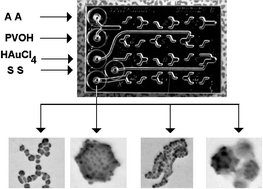Formation of isolated and clustered Au nanoparticles in the presence of polyelectrolyte molecules using a flow-through Si chip reactor
Abstract
The formation of colloidal gold at room temperature was studied in a micro-reaction system.

* Corresponding authors
a
Technische Universität Ilmenau, Fakultät für Mathematik und Naturwissenschaften, Institut für Physik, Fachgebiet Physikalische Chemie/Mikroreaktionstechnik, PF 10 05 65, D-98684 Ilmenau, Germany
E-mail:
michael.koehler@tu-ilmenau.de
Fax: 693179
Tel: (49)-(0)3677-693655
b Institute of Physical High Technology Jena, Albert-Einstein-Str. 9, D-07745 Jena, Germany
The formation of colloidal gold at room temperature was studied in a micro-reaction system.

 Please wait while we load your content...
Something went wrong. Try again?
Please wait while we load your content...
Something went wrong. Try again?
J. M. Köhler, J. Wagner and J. Albert, J. Mater. Chem., 2005, 15, 1924 DOI: 10.1039/B417868H
To request permission to reproduce material from this article, please go to the Copyright Clearance Center request page.
If you are an author contributing to an RSC publication, you do not need to request permission provided correct acknowledgement is given.
If you are the author of this article, you do not need to request permission to reproduce figures and diagrams provided correct acknowledgement is given. If you want to reproduce the whole article in a third-party publication (excluding your thesis/dissertation for which permission is not required) please go to the Copyright Clearance Center request page.
Read more about how to correctly acknowledge RSC content.
 Fetching data from CrossRef.
Fetching data from CrossRef.
This may take some time to load.
Loading related content
